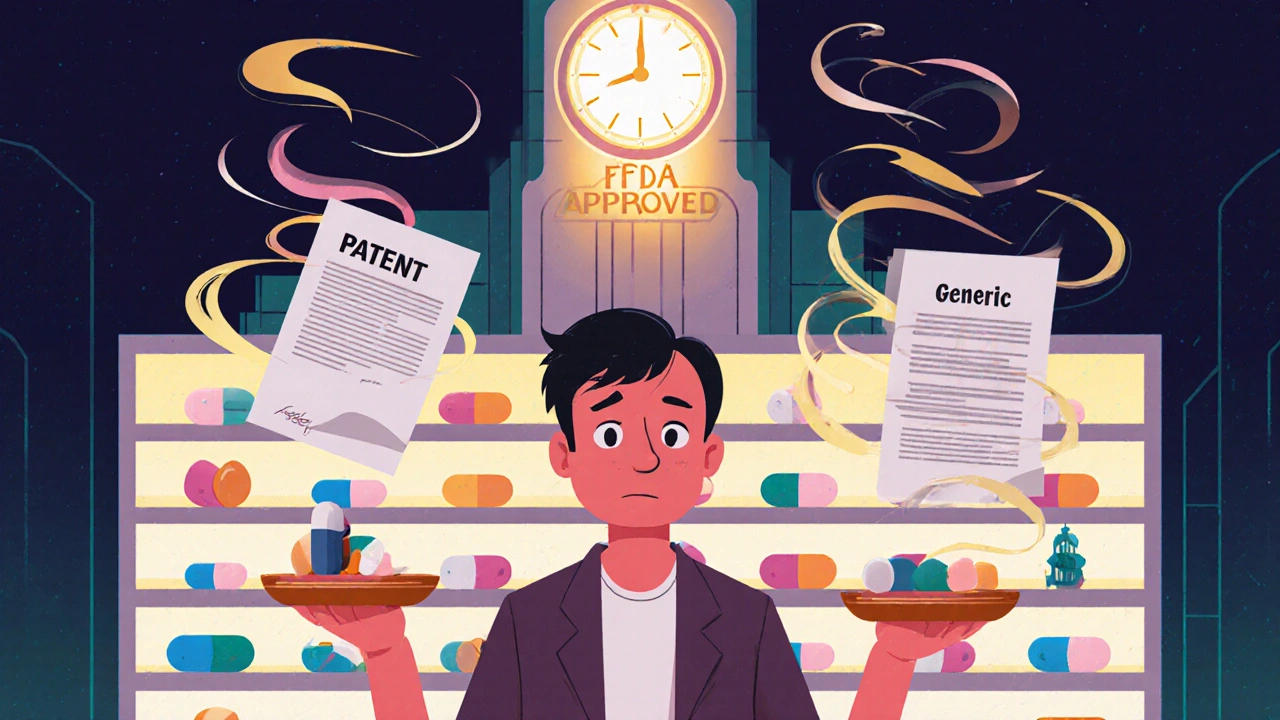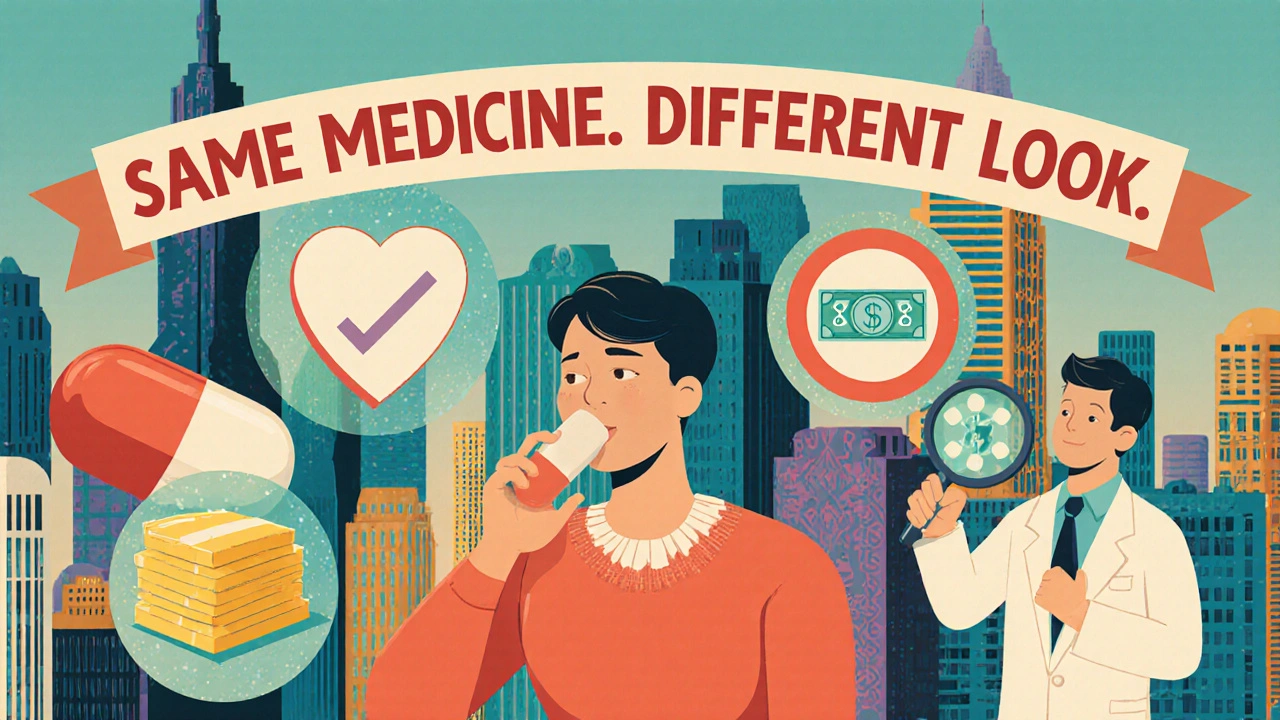Have you ever picked up your prescription and thought, "Wait, this pill looks nothing like last time"? You’re not imagining it. The color changed. The shape’s different. Even the letters stamped on it don’t match. And yet, your doctor still says it’s the same medicine. What’s going on?
It’s not a mistake. It’s not a mix-up. It’s the law.
In the United States, trademark laws require generic drugs to look different from brand-name versions-even if they work exactly the same. This isn’t about quality. It’s not about safety. It’s about legal boundaries that have been in place for decades, designed to protect companies’ branding while still letting cheaper alternatives reach patients.
Same medicine, different look
Let’s start with the basics: a generic drug contains the exact same active ingredient as its brand-name counterpart. If you take lisinopril for high blood pressure, whether it’s sold as Zestril or as a generic, your body gets the same molecule. Same dose. Same effect. Same risks.
The FDA requires generic manufacturers to prove this through strict bioequivalence testing. Studies show that the difference in how your body absorbs a generic versus a brand-name drug is typically less than 3.5%. That’s well within the FDA’s acceptable range of 80% to 125% absorption. In other words, your body can’t tell the difference.
So why does the generic pill look like a completely different object?
Trademark law isn’t about science-it’s about identity
Think of a Coca-Cola bottle. No other soda company can make a bottle that looks just like it. Why? Because trademark law protects visual identity. It stops consumers from being confused. If you see a red can with white script, you know it’s Coca-Cola. That’s the point.
The same rule applies to pills. Brand-name drug companies spend millions designing their products: the perfect shade of blue, the exact oval shape, the logo stamped on the surface. That’s their brand. And trademark law gives them exclusive rights to that appearance.
When a patent expires and a generic version enters the market, the law says: you can copy the medicine, but not the look. So generic manufacturers have to change the color, shape, size, or markings. They can’t use the same design as the brand-name drug-or any other drug already on the market.
This isn’t just a suggestion. It’s enforced. The FDA won’t approve a generic drug if it’s visually identical to another product already sold in the U.S.
What exactly changes?
When you switch from a brand-name drug to a generic, here’s what you might notice:
- Color: The brand might be a light blue. The generic could be white, yellow, or even pink.
- Shape: Round becomes oval. Capsule turns into tablet.
- Size: The generic might be slightly bigger or smaller.
- Markings: The letters or numbers stamped on the pill are different.
- Flavor or coating: For liquids or chewables, the taste might change slightly.
These changes are all in the inactive ingredients-things like dyes, binders, fillers, and coatings. They don’t affect how the drug works. But they’re enough to satisfy trademark law.
Interestingly, the FDA actually recommends that generic makers try to match the size and shape of the brand-name drug when possible. Why? To reduce patient confusion. But they still can’t copy the exact look.

Why does this matter to you?
Most people don’t care what their pill looks like-as long as it works. And for most, it does. A 2022 Consumer Reports survey found that 89% of patients reported no difference in effectiveness between generics and brand-name drugs.
But here’s the catch: appearance changes can cause confusion.
Imagine someone taking five pills a day for heart disease, diabetes, and depression. One day, they refill their prescription and the pill looks totally different. They panic. Did they get the wrong medicine? Did the pharmacy make a mistake? Did it stop working?
That fear is real. Studies show that when patients see a new-looking pill, they’re more likely to skip doses, stop taking it, or call their doctor unnecessarily. Some even think the generic is inferior-when it’s not.
Pharmacies know this. That’s why they put special labels on your bottle: "Generic version of Zestril. Same active ingredient. Different appearance." They’re trying to prevent mistakes.
Who benefits? Who loses?
The system was designed to balance two goals:
- Let cheaper drugs enter the market after patents expire.
- Protect companies’ investments in branding.
It works. Generics make up about 90% of all prescriptions filled in the U.S.-but only cost about 23% of total drug spending. That’s billions saved every year.
Brand-name companies keep their identity. Patients get affordable medicine. Generic manufacturers get to compete.
But the cost? Confusion. Anxiety. Mistakes.
There’s no perfect solution. If generics looked identical, trademark law would be broken. If they looked wildly different, patients would be more confused. The current system is a compromise.

What should you do?
Here’s what works in real life:
- Don’t panic if your pill looks different. Check the label. It should say the generic name and the brand name it replaces.
- Ask your pharmacist when you get a new refill. A quick, "Why does this look different?" can clear up confusion.
- Keep a list of your meds, including how they look. Take a photo of the pill before you open the bottle. It helps if you need to describe it later.
- Don’t assume cost = quality. A cheaper-looking pill isn’t weaker. It’s just made by a different company.
Most importantly: never stop taking your medicine because the pill looks different. Talk to someone first.
The future: Will this change?
There’s growing pressure to fix this. Some experts argue that the current system causes more harm than good. Patient confusion leads to missed doses, ER visits, and unnecessary doctor calls-all of which cost more than the savings from generics.
The FDA has started nudging manufacturers toward more consistent shapes and sizes. Some new generics now look nearly identical to their brand-name versions-just with different colors or markings.
But trademark law isn’t going away. It’s too deeply rooted in U.S. intellectual property rules. So the best we can hope for is better labeling, clearer communication, and more education.
For now, the rule stays: same medicine, different look. And that’s by design.
Why do generic drugs look different from brand-name drugs?
Trademark laws in the U.S. prevent generic drugs from looking identical to brand-name drugs or any other existing medication. This is to avoid consumer confusion between products from different manufacturers. While the active ingredient is the same, the color, shape, size, and markings must differ to comply with these legal protections.
Are generic drugs as effective as brand-name drugs?
Yes. The FDA requires generic drugs to have the same active ingredient, strength, dosage form, and route of administration as the brand-name version. They must also prove they’re absorbed into the body at the same rate and to the same extent. Studies show differences in absorption are typically under 3.5%, well within the FDA’s acceptable range of 80% to 125%.
Can the different appearance affect how the drug works?
No. Changes in color, shape, or size are made using inactive ingredients like dyes, fillers, or coatings-substances that don’t impact how the medicine works in your body. The active ingredient, which determines the drug’s effect, remains unchanged.
Why don’t generic manufacturers just copy the brand’s look?
Trademark law protects the visual identity of brand-name drugs. Copying the exact appearance would be considered infringement. Even if the medicine is identical, the FDA will not approve a generic that looks too similar to another drug already on the market.
What should I do if my generic pill looks different from last time?
Check the label on your bottle-it should list both the generic and brand names. If you’re unsure, ask your pharmacist. Don’t stop taking the medication. Appearance changes are normal and legal. Many pharmacies now use warning labels to alert patients to these changes.
Do generic drugs cost less because they’re lower quality?
No. Generic drugs cost 80-85% less because manufacturers don’t have to repeat expensive clinical trials or marketing campaigns. The FDA holds them to the same quality, safety, and effectiveness standards as brand-name drugs. The lower price reflects reduced development costs, not lower quality.


Emily Nesbit
November 27, 2025 AT 14:22The FDA’s bioequivalence standards are rigorously enforced-generic drugs must demonstrate absorption rates within 80–125% of the brand-name version. That’s not a loophole; it’s a scientifically validated threshold. The visual differences? Purely aesthetic and legally mandated. No pharmacokinetic compromise. Period.